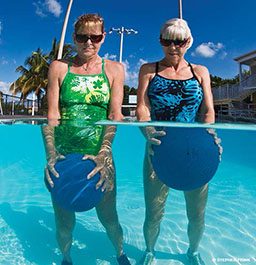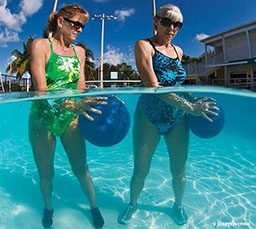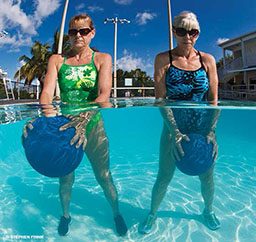Human life begins in liquid, with amniotic fluid protecting and surrounding the prenatal body. The human body is made up of four major components: water, fat, minerals and proteins; water accounts for 60-70 percent of the body’s mass. So it seems natural that we are drawn to water for consumption, exercise, recreation and relaxation.
The physical principles of immersion in water also provide benefits to the body. When the body is submerged, hydrostatic pressure can decrease swelling, aid in blood circulation and support and massage the body. The weightlessness you feel in the water also means that the water is reducing the compression of your joints. And, assuming the water temperature is not too cold, your heart rate decreases after submersion, resulting in a relaxed state.
Water also provides a great environment for rigorous exercise. It is 12 times more resistant than air, and exercising in water provides bidirectional resistance that is difficult to obtain on land without specialized equipment.
Scuba divers must work the water efficiently — swimming, streamlining and managing air consumption by moving smoothly. As with any sport, maintaining a healthy body and good physical state are key to maximizing your experience. Water aerobics provides a diverse exercise program, and its bidirectional resistance targets opposing muscle groups throughout the entire body.
A typical one-hour water aerobics class consists of five minutes of warm-up exercises using short lever movements (i.e., jogging, marching, side-stepping, paddle-wheeling forearms, plunging arms, etc.), followed by five minutes of stretching, five minutes of cardiovascular warm-ups, 25-30 minutes of cardio, 10 minutes of muscular conditioning and five minutes of final stretching. The water’s resistance, coupled with the force behind each movement, increases strength and endurance while burning 400-500 kilocalories per hour.
Try the following five shallow-water exercises to condition the core. The water depth should be between the chest and the belly button while your feet are flat on the pool floor. These exercises require the use of an approximately 8-inch playground ball. They can be performed using repetitions (16-32 repetitions each) or time (one minute each) or as interval training (vigorous exercise for 30-60 seconds) between each ball exercise. If you choose to use these exercises in interval training, the duration of each ball exercise portion should be about three times as long as each cardio portion.
Before completing each exercise, follow these steps to align your body:
- Stand on the pool floor with your feet hip distance apart or wider, being careful not to hyperextend your knees. Draw your navel to the spine, and hold the contraction throughout the exercises to keep your core engaged.
- Place your hands on top of the ball, and press the ball down toward the pool floor. Keep the ball close to your hips and the tops of your thighs.
- Stabilize your shoulders by rolling them back and down and retracting the shoulder blades (squeeze the shoulder blades together).
Tricep Press

- Keeping the elbows tight beside the body, inhale as you bend your elbows to a 90-degree angle, resisting the upward force of the ball. Your palms should be on top of the ball, toward the pool floor.
- Exhale as you extend your elbows, pressing the ball back toward the hips and tops of the thighs
Oblique Twist (Short Lever or Long Lever)

- Keeping the elbows tight beside the body, bend your elbows to a 90-degree angle, resisting the upward force of the ball. Your palms should be on top of the ball, toward the pool floor.
- Square your hips forward, and plant your feet on the pool floor. Inhale twist from the belly-button area to the left (around 10 o’clock), exhale and hold. Inhale twist from the belly-button area to the right (around 2 o’clock), exhale and hold.
Tip: To make this a long-lever twist, extend the arms, keeping the ball submerged, and twist.
Latissimus Dorsi

- Straighten your arms, and press the ball to the tops of your thighs.
- Inhale as you lift your arms straight out in front of you, only high enough that you can keep the ball under water.
- Exhale as you press down on the ball to return it to the tops of your thighs.
Adductors Squeeze

- Place the ball between your legs just above the knees.
- Stand tall, and squeeze the ball with the inner thigh muscles (adductors). This is a quick action.
Rectus Abdominal Crunch

- With extended arms, allow the ball to come about 6-12 inches in front of your body.
- Exhale as you draw the base of the rib cage to the top of the hip bones for a crunch. Inhale as you extend to stand, releasing the crunch. Resist the pressure of the ball throughout the movement.
It is important to participate in exercise programs that are diverse and designed to focus on muscle movement, muscular strength, endurance and functional movements. Before beginning any exercise program or changing your physical activity patterns, you should always consult with your physician.
DAN Note: To avoid an increased risk of decompression sickness, DAN recommends that divers avoid strenuous exercise for 24 hours after making a dive. During your annual physical exam or following any changes in your health status, consult your physician to ensure you have medical clearance to dive.
© Alert Diver — Q4 Fall 2014